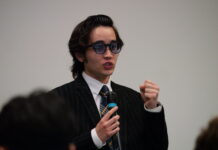As the Inland Empire (IE) continues to experience population growth, the demand for qualified educators has reached a critical point, posing significant challenges for local schools. Assistant Dean and Director of Teacher Education, Dr. Frances Valdovinos, highlights the plans for newly acquired funding, awarded to the University of California, Riverside (UCR) School of Education (SOE) to help remedy the teacher shortage in the IE. The million-dollar grant from the Inland Empire Collaborative group will fund multiple programs geared towards supporting students from K-16 up through their higher education to ensure they are properly prepared to meet the career requirements for teaching.
According to Dr. Valdovinos, the SOE supports teacher education not only on the UCR campus, but also “through partnerships” with “Riverside Unified School District, Riverside Community College, Coachella Valley Unified School District, College of the Desert and Palm Desert Center.” She states that the primary focus of all the newly made and current teacher education programs is to create supportive pathways to serve future educators of color within the IE region. She specifies that the SOE wants to respond to the teacher shortage in a “culturally responsive way” to meet the needs of the community. Thus, creating a space for future students to feel included in their learning environment.
Within the IE, Dr. Valdovinos declares a need for diversity among teaching professionals. He further states that “there is research” supporting the idea that students who can relate to their mentors or teachers “have a higher percentage of being successful.” Therefore, the SOE has several programs focused on growing the diversity within the work pool.
For example, Fueling the Inland Empire Region with Community Educators (FIERCE) is a program specifically for students who will continue to work and reside in the IE. According to the FIERCE Website, the goal for participants is to become “community-ready” and “equity-centered” to strengthen the IE teacher workforce. Another program, known as the Black Community Education Promise Program (BCEP) is dedicated to undergraduate SOE students who have an interest in serving the African American community after graduation.
The programs concentrate on creating educators that are specialized to serve a particular student population. In most of the programs, Dr. Valdovinos explains there is a “mentorship component, financial component and a professional development component” to ensure that students get the necessary support from start to finish of their academic career to succeed in their profession. In a more general sense, the programs aim to “increase the number of students of color” and the number of students who pursue teaching careers.
Another program the grant will support is Supporting Teacher Education Through Partnerships (STEP). STEP’s main goal is to supply “highly qualified teachers” in multiple disciplines to areas with a teacher shortage. The partnership with the Coachella Valley School District will allow student-teachers to connect with seasoned teacher-mentors in a “hands-on” classroom environment.
Dr. Valdovinos affirms that these programs are in place to “improve” the “academic performance” of minority students. Therefore, increasing graduation rates, and hopefully “inspiring students” into higher education. SOE is trying to create “well-rounded educators” and “critical thinkers” to cater to the “younger more diverse generation.” She stresses that the goal is to have “support systems” for students to be successful from elementary through high school and college to complete the educator career track.
Currently, SOE graduates can achieve their teaching credentials in two ways. Dr. Valdovinos explains that graduates at UCR’s Teacher Education Program can pursue their credentials within a year or pursue their Master’s and credentials, also within a year. She likes to encourage the candidates to acquire their Master’s of Education, with a teaching emphasis, and the credentials with any subject they desire. Also, there are resources and scholarships available to complete the Master’s program, such as the Cal Grant, Teach Grant and Golden State Grant. She states the importance that “students understand that these financial services are available.”
As for future programs that will be supported by the grant, the SOE aims to offer teaching-centered career pathways in IE high schools. In this case, she hopes to prepare students to take the necessary classes to succeed in higher education, whether it be community college or the UC system. She states that there is a “disparity of students in the region” that continue to accomplish a college degree; therefore, it is crucial to “offer that support” because the students “are more than capable” of succeeding.
However, the objective of the pathways is for students to serve as educators in their communities, says Dr. Valdovinos. There will be an initial meeting next month about upcoming programs that will be made possible by the new grant. The goal is to find what is needed in the K-12 sector, the community college sector and at UCR to facilitate the progress of teacher candidates.
For Dr. Valdovinos, the purpose of the grant is to “ensure equity” and organize support structures for future and current SOE undergraduates. Lastly, Dr. Valdovinos defines the new generation of students as “very different,” which calls for a different type of educator. As explained by Dr. Valdovinos, the School of Education will use the grant to shape future educators who are focused on equity, social justice and restorative justice to fulfill the need in present Inland Empire classrooms.







